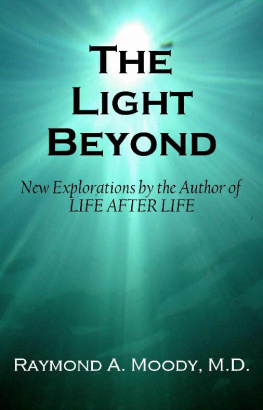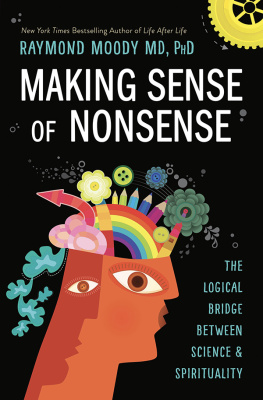
I was terribly ill and near death with heart problems at the same time that my sister was near death in another part of the same hospital with a diabetic coma. I left my body and went into the corner of my room, where I watched them work on me down below.
Suddenly, I found myself in conversation with my sister, who was up there with me. I was very attached to her, and we were having a great conversation about what was going on down there when she began to move away from me.
I tried to go with her but she kept telling me to stay where I was. Its not your time, she said. You cant go with me because its not your time. Then she just began to recede off into the distance through a tunnel while I was left there alone.
When I awoke, I told the doctor that my sister had died. He denied it, but at my insistence he had a nurse check on it. She had in fact died, just as I knew she had.
THE LIGHT BEYOND
WHAT HAPPENS AFTER DEATH IS SO UNSPEAKABLY GLORIOUS THAT OUR IMAGINATIONS AND OUR FEELINGS DO NOT SUFFICE TO FORM EVEN AN APPROXIMATE CONCEPTION OF IT.C. J. Jung
THE LIGHT
BEYOND
RAYMOND A. MOODY, JR., M.D.
with Paul Perry
Foreword by Andrew Greeley
Grateful acknowledgment is made for permission to reprint the following excerpts:
Page 2124 Reprinted with permission from James H. Lindley, Sethyn Bryan & Bob Conley. Near-death experiences in a Pacific Northwest American population. The Evergreen study. Anabiosis: The Journal of Near-Death Studies, 1981, 1, 104124.
Page 2627 Reprinted with permission from Kenneth Ring. Precognitive and prophetic visions in near-death experiences. Anabiosis: The Journal of Near-Death Studies, 1982, 2, 4774.
Page 184185 Reprinted with permission from J. Timothy Green & Penelope Friedman. Near-death experiences in a Southern California population. Anabiosis: The Journal of Near-Death Studies, 1983, 3, 7795.
Page 156163 Reprinted by permission of Putnam Publishing Group, Life at Death by Kenneth Ring, copyright 1980 by Kenneth Ring. British rights made by permission of the author.
2011 by Raymond A. Moody, Jr. All rights reserved.
Contents
R aymond Moody has achieved a rare feat in the quest for human knowledge: he has created a paradigm.
In his classic The Structure of Scientific Revolutions, Thomas Kuhn points out that scientific revolutions occur when someone creates a new perspective, a new model, a new approach to reality. After such a breakthrough, great progress can be made that was previously impossible. Scientific progress, Kuhn contends, is less the result of the dogged work of applying the scientific method to problems and more the result of a brilliant and original insight that opens the way for such work.
As Dr. Moody notes in the present volume, Life After Life is not the first book about such experiences. Indeed, Dr. Carol Zaleski of Harvard, in her fascinating study, Otherworld Journeys, tells us that the literature of the Middle Ages is filled with similar accounts. Moody did not, then, discover these experiences. But he put a name to them, and that name, NDEnear-death experiencesprovided the paradigm for the considerable research that has occurred since the publication of Life After Life.
Why is giving a phenomenon the right name so important? Stephen Hawking, the great English theoretical physicist, has said that the name black hole for the phenomenon he is studying is of critical importance. So in every human activity, since we are naming creaturescreatures who bestow meaning on phenomenathe names we choose determine how we explain the phenomena and what others do with our work.
Not only did Dr. Moody rediscover an experience that, as we now know, is widespread in the human condition, but he also, by assigning that experience the precisely appropriate label, assured that there would be more research and study of the experience. It is impossible to overestimate the importance of such a contribution to human knowledge.
The Light Beyond, like Dr. Moodys previous efforts, is characterized by openness, sensitivity, and modesty. The last characteristic is, I think, the most important in his work. He makes no extreme claims for his findings. The very label near-death experience is so effective because it is so utterly modest. Dr. Moody does not claim that he has proved anything more than the existence and the widespread prevalence of the NDE.
Has the NDE research scientifically proved that there is life after death? I think not, despite some of the enthusiastic claims that have been made for it. It merely proves that at the time of death many people undergo a benign and promising experience. I dont think that on the subject of human survival anything more than that conclusion can be expected. Thus I fail to see why much of the scientific and medical establishments cannot be content with the demonstrated fact that these experiences occur and study them with interest and respect.
Does the NDE research increase the probabilities of human survival beyond death? I rather think it does; but, as long as one is working with probabilities, there is still required a leap of faith, which most of those who have had an NDE do not hesitate to make.
Near the end of this book, Dr. Moody turns to a man who was perhaps Americas greatest thinker, William James. The NDE is a noetic experience, an experience of illumination that purports to provide understanding that is unassailable for one who has encountered it. As James himself remarks, such experiences cannot constrain acceptance from empirical science; but, since such experiences occur, empirical science cannot claim a monopoly on human ways of knowing. Carol Zaleski arrives at the same conclusion at the end of her investigation; as does Dr. Moody, she falls back on the categories of William James: the NDE is an experience of mystical illumination.
Otherworld visions are products of the same imaginative power that is active in our ordinary ways of visualizing death; our tendency to portray ideas in concrete, embodied, and dramatic forms; the capacity of our inner states to transfigure our perception of outer landscapes; our need to internalize the cultural map of the physical universe; and our drive to experience that universe as a moral and spiritual cosmos in which we belong and have a purpose.
The NDE then is one of many hope renewal experiences that occur in human lifethough a spectacular one. It is a hint of an explanation, though a powerful hint.
It is not the only hint.
Dr. Zaleski, in correspondence with me about her work, remarked that her letter had been delayed by the advent of her first child. I wrote back that I wondered if the birth of a child might not be at least as strong a hint of an explanation as an NDE, if a much more commonplace hint. From the perspective of the Ultimate, the question might well be whether He can give better hints or more hints than He already has.
Be that as it may, the hints, the rumors of angels, are not much use to those who are inclined to listen to them, unless they influence their lives. As Dr. Zaleski remarks, A conviction that life surpasses death, however intensely felt, will eventually lose its vitality and become a mere fossil record, as alien as any borrowed doctrine, unless it is tested and rediscovered in daily life.
As I read Dr. Moodys exploration of light and Light, he seems to be making the same argument. The Light came into the darkness and the darkness could not put it out.











![Raymond A. Moody Jr. - Coming Back - A Psychiatrist Explores Past-Life Journeys [fixed]](/uploads/posts/book/131649/thumbs/raymond-a-moody-jr-coming-back-a-psychiatrist.jpg)


